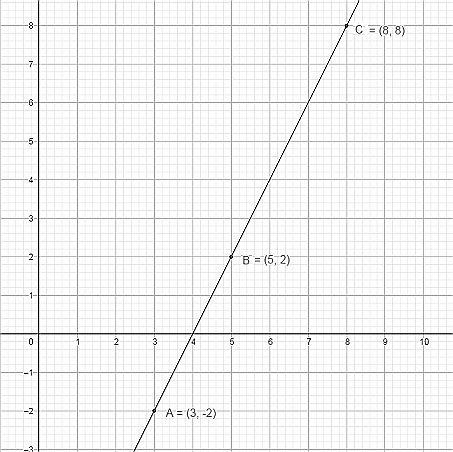
Show by section formula that the points (3, -2), (5, 2) and (8, 8) are collinear.
Answer
557.4k+ views
Hint:
1) The section formula gives the coordinates of a point P(x, y) which divides the line joining two points $A\left( {{x}_{1}},{{y}_{1}} \right)$ and $B\left( {{x}_{2}},{{y}_{2}} \right)$ in the ratio AP : PB = m : n, internally or externally.
2) For internal division: $P(x,y)=\left( \dfrac{m{{x}_{2}}+n{{x}_{1}}}{m+n},\dfrac{m{{y}_{2}}+n{{y}_{1}}}{m+n} \right)$ .
3) For external division: $P(x,y)=\left( \dfrac{m{{x}_{2}}-n{{x}_{1}}}{m-n},\dfrac{m{{y}_{2}}-n{{y}_{1}}}{m-n} \right)$ .
4) For three points $A\left( {{x}_{1}},{{y}_{1}} \right)$ , $B\left( {{x}_{2}},{{y}_{2}} \right)$ and $C\left( {{x}_{3}},{{y}_{3}} \right)$ to be collinear, the ratio m : n should be same in both ${{x}_{3}}=\dfrac{m{{x}_{2}}+n{{x}_{1}}}{m+n}$ and ${{y}_{3}}=\dfrac{m{{y}_{2}}+n{{y}_{1}}}{m+n}$ .
i.e. $\dfrac{m}{n}=\dfrac{{{x}_{1}}-{{x}_{3}}}{{{x}_{3}}-{{x}_{2}}}=\dfrac{{{y}_{1}}-{{y}_{3}}}{{{y}_{3}}-{{y}_{2}}}$ .
Complete step by step solution:
Let's say that the points are $A\left( {{x}_{1}},{{y}_{1}} \right)=\left( 3,-2 \right)$ , $B\left( {{x}_{2}},{{y}_{2}} \right)=\left( 5,2 \right)$ and $C\left( {{x}_{3}},{{y}_{3}} \right)=\left( 8,8 \right)$ .
We know that, using the section formula, that for the points to be collinear: $\dfrac{m}{n}=\dfrac{{{x}_{1}}-{{x}_{3}}}{{{x}_{3}}-{{x}_{2}}}=\dfrac{{{y}_{1}}-{{y}_{3}}}{{{y}_{3}}-{{y}_{2}}}$ .
Here, $\dfrac{{{x}_{1}}-{{x}_{3}}}{{{x}_{3}}-{{x}_{2}}}=\dfrac{3-8}{8-5}=\dfrac{-5}{3}$ and $\dfrac{{{y}_{1}}-{{y}_{3}}}{{{y}_{3}}-{{y}_{2}}}=\dfrac{-2-8}{8-2}=\dfrac{-10}{6}=\dfrac{-5}{3}$.
Since both the values are the same, the points are collinear. Also, a negative value of $\dfrac{m}{n}=\dfrac{-5}{3}$ suggests that the point C is outside AB and the ratio AC : BC = 5 : 3.
The position of the three points is shown below:

Note:
1) There are many ways to show that three points A, B and C are collinear (in a straight line):
2) Section formula (Ratio / Slope method).
3) Distance method: AB + BC = AC.
4) Area method: Area of Δ ABC = 0.
1) The section formula gives the coordinates of a point P(x, y) which divides the line joining two points $A\left( {{x}_{1}},{{y}_{1}} \right)$ and $B\left( {{x}_{2}},{{y}_{2}} \right)$ in the ratio AP : PB = m : n, internally or externally.
2) For internal division: $P(x,y)=\left( \dfrac{m{{x}_{2}}+n{{x}_{1}}}{m+n},\dfrac{m{{y}_{2}}+n{{y}_{1}}}{m+n} \right)$ .
3) For external division: $P(x,y)=\left( \dfrac{m{{x}_{2}}-n{{x}_{1}}}{m-n},\dfrac{m{{y}_{2}}-n{{y}_{1}}}{m-n} \right)$ .
4) For three points $A\left( {{x}_{1}},{{y}_{1}} \right)$ , $B\left( {{x}_{2}},{{y}_{2}} \right)$ and $C\left( {{x}_{3}},{{y}_{3}} \right)$ to be collinear, the ratio m : n should be same in both ${{x}_{3}}=\dfrac{m{{x}_{2}}+n{{x}_{1}}}{m+n}$ and ${{y}_{3}}=\dfrac{m{{y}_{2}}+n{{y}_{1}}}{m+n}$ .
i.e. $\dfrac{m}{n}=\dfrac{{{x}_{1}}-{{x}_{3}}}{{{x}_{3}}-{{x}_{2}}}=\dfrac{{{y}_{1}}-{{y}_{3}}}{{{y}_{3}}-{{y}_{2}}}$ .
Complete step by step solution:
Let's say that the points are $A\left( {{x}_{1}},{{y}_{1}} \right)=\left( 3,-2 \right)$ , $B\left( {{x}_{2}},{{y}_{2}} \right)=\left( 5,2 \right)$ and $C\left( {{x}_{3}},{{y}_{3}} \right)=\left( 8,8 \right)$ .
We know that, using the section formula, that for the points to be collinear: $\dfrac{m}{n}=\dfrac{{{x}_{1}}-{{x}_{3}}}{{{x}_{3}}-{{x}_{2}}}=\dfrac{{{y}_{1}}-{{y}_{3}}}{{{y}_{3}}-{{y}_{2}}}$ .
Here, $\dfrac{{{x}_{1}}-{{x}_{3}}}{{{x}_{3}}-{{x}_{2}}}=\dfrac{3-8}{8-5}=\dfrac{-5}{3}$ and $\dfrac{{{y}_{1}}-{{y}_{3}}}{{{y}_{3}}-{{y}_{2}}}=\dfrac{-2-8}{8-2}=\dfrac{-10}{6}=\dfrac{-5}{3}$.
Since both the values are the same, the points are collinear. Also, a negative value of $\dfrac{m}{n}=\dfrac{-5}{3}$ suggests that the point C is outside AB and the ratio AC : BC = 5 : 3.
The position of the three points is shown below:

Note:
1) There are many ways to show that three points A, B and C are collinear (in a straight line):
2) Section formula (Ratio / Slope method).
3) Distance method: AB + BC = AC.
4) Area method: Area of Δ ABC = 0.
Recently Updated Pages
Why are manures considered better than fertilizers class 11 biology CBSE

Find the coordinates of the midpoint of the line segment class 11 maths CBSE

Distinguish between static friction limiting friction class 11 physics CBSE

The Chairman of the constituent Assembly was A Jawaharlal class 11 social science CBSE

The first National Commission on Labour NCL submitted class 11 social science CBSE

Number of all subshell of n + l 7 is A 4 B 5 C 6 D class 11 chemistry CBSE

Trending doubts
What is meant by exothermic and endothermic reactions class 11 chemistry CBSE

10 examples of friction in our daily life

One Metric ton is equal to kg A 10000 B 1000 C 100 class 11 physics CBSE

1 Quintal is equal to a 110 kg b 10 kg c 100kg d 1000 class 11 physics CBSE

Difference Between Prokaryotic Cells and Eukaryotic Cells

What are Quantum numbers Explain the quantum number class 11 chemistry CBSE




